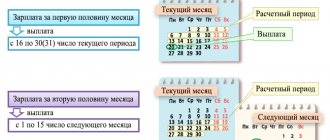Report 12: three important indicators in its preparation
Each organization is obliged to submit monthly, before the 12th day of the month following the reporting period, the state statistical reporting 12th “Labor Report” (hereinafter referred to as the labor report) to the statistical authorities. In this material we propose to understand the procedure for calculating the most important statistical indicators.
The labor report is submitted to the statistical authorities either in the form of an electronic document using special software, or on paper to the state statistics authorities at the place of registration (clause 2 of Instructions No. 163).
Document:
Belstat Resolution No. 163 of August 19, 2013 “On approval of the state reporting form 12 “Labor Report” and instructions for its completion” (hereinafter referred to as Instructions No. 163).
Indicator “Average headcount”
The average headcount does not include:
– external part-time workers;
– citizens working under civil law contracts;
– employees on maternity leave to care for a child until he or she reaches the age of 3 years (including the adoption of a child under the age of 3 months);
– those who did not show up for work due to temporary disability or caring for the sick (subject to the presence of a certificate of incapacity for work or a certificate);
– those on leave without pay (including in connection with obtaining an education), except for those on leave granted at the initiative of the employer;
– persons under investigation until a court verdict is passed;
– patients with chronic alcoholism placed for treatment in drug treatment departments of psychiatric (psychoneurological) institutions;
– donor employees for days of donating blood and its components (except for days when average earnings are maintained at the expense of the employer), as well as rest days provided after this.
Employees hired on a part-time basis are taken into account as whole units when calculating the payroll number, and in proportion to the time worked when calculating the average payroll.
Example (we will do the calculation using the example of June)
The healthcare institution (dentistry) employs 125 people, of which:
1 – external part-time worker at 0.5 rate;
42 are doctors, of which 1 doctor is hired at 0.5 times the salary, 1 doctor works on an individual schedule daily for 4 hours;
48 – medical workers with secondary specialized medical education (on June 6, 2021, the main employee was dismissed);
34 – administrative, managerial and other personnel, of which 1 employee has a shortened working week on the basis of part three of Art. 114 Labor Code (disabled group II).
Document:
Labor Code of the Republic of Belarus (hereinafter referred to as the Labor Code).
Important!
Persons transferred to work on a part-time basis at the initiative of the employer are reflected in the average number of employees as whole units (subclause 10.5, clause 10 of the Labor Instructions).
Document:
Resolution of the Ministry of Statistics of the Republic of Belarus dated July 29, 2008 No. 92 “On approval of the Instructions for filling out labor statistics in state statistical observation forms” (hereinafter referred to as the Labor Instructions).
In the organization, 2 doctors work part-time, so they worked 146 person-hours (132 × 0.5 + 4 × 20, where 132 hours is the monthly norm for June 2021 for dentists with a 33-hour work week; 20 – number of working days in June 2019).
The total number of man-days worked by these workers will be 22 (146 / 6.6 hours, where 6.6 is the average daily rate for dentists with a 5-day work week (33 hours / 5 days)).
The average number of people working part-time for June will be 1 person (22/20 working days according to the calendar).
For reference:
an employee who has reduced working hours, in accordance with the law, is counted as a whole unit in the average number of employees (subclause 10.6, clause 10 of the Labor Instructions).
Data for calculating the average headcount are presented in the table.
* On June 6, an employee was fired, but the number of employees for this day does not decrease, since the day of dismissal is the last working day.
Thus:
– average number of employees – 120 people ((1,174 + 1,419 + 1,020) / 30) – reflected in line 1 gr. 1 section I “Number of employees, wages and hours worked”;
– doctors (all specialties) – 39 people (1,174 / 30) – reflected in page 123 gr. 1 section IV “Number and wage fund of certain categories of workers”;
– medical workers with secondary specialized medical and pharmaceutical education – 47 people (1,419 / 30) – reflected on page 124 gr. 1 section IV.
Important!
The following are not included in the average number of citizens who performed work under civil contracts:
– employees who are on the payroll of the organization and have entered into a civil contract to perform work in the same organization;
– individual entrepreneurs without forming a legal entity;
– citizens who have entered into a civil contract for the creation of intellectual property.
Indicator “Staff headcount on average for the period”
The average number of employees on payroll for the last month of the reporting period is calculated by summing the number of employees on the payroll for each calendar day and dividing the resulting amount by the number of calendar days in the month.
In the example discussed above, the payroll number will be 124 people (3,717 / 30 = 123.9). It is reflected on page 20 gr. 1 section II “The average number of employees on the payroll for the period, the average number of citizens performing work under civil contracts, and external part-time workers.”
The list of employees on average for the period does not include employees on maternity leave, in connection with the adoption of a child under the age of 3 months, caring for a child until he reaches 3 years old, external part-time workers and citizens who performed work under civil law contracts.
The average number of employees on the payroll for the reporting period is determined by summing the average monthly number of employees for all months that have elapsed during the reporting period and dividing the resulting amount by the number of months in the reporting period (clause 9 of the Labor Instructions).
The average number of citizens who performed work under civil contracts is determined based on the accounting of these persons for each calendar day as whole units during the entire period of validity of this contract.
The average number of external part-time workers is calculated in proportion to the actual time worked.
In our example - 1 person (since 0.5 is rounded to 1), which is reflected in page 20 gr. Section 5 II.
Important!
An employee registered within one organization as an internal part-time worker or working more than full-time is not included in the average number of external part-time workers.
Indicator "Wage Fund"
The wage fund (WF) includes:
– accrued wages to paid and unpaid employees and external part-time workers for work performed and time worked;
– incentive and compensatory payments;
– payment for unworked time;
– other payments included in the salary package, regardless of the sources of financing and the timing of their actual payment.
Important!
Funds accrued for labor and social vacations are included in the wages of the reporting month only in the amount attributable to vacation days in the reporting month. Amounts due for vacation days in the next month are included in the next month's payroll.
The full list of payments included in the FZP is named in paragraphs. 58–66 of the Labor Instructions, and payments that are not included are in clause 70 of the Labor Instructions.
In the example discussed above, the workers’ wages for June amounted to 169,263.4 rubles. , including:
– wages for time worked and work performed, incl. additional payments for combining professions (positions), expanding the service area (increasing the volume of work performed), performing the duties of a temporarily absent employee - 98,264.6 rubles. (including the salary of an external part-time worker - 368.6 rubles);
– payment for labor leave – 10,624.3 rubles. (including vacations in June - 6,655.9 rubles, July - 3,214.2 rubles, August - 754.2 rubles);
– monetary compensation for unused labor leave – 57.2 rubles;
– bonus – 37,117.3 rubles. (including bonus for external part-time worker - 55 rubles);
– financial assistance to all employees – 3,100 rubles;
– one-time payment in connection with the anniversary date – 100 rubles;
– one-time payment for Medical Worker Day – 20,000 rubles. (including persons on parental leave to care for a child under 3 years old - 200 rubles).
Important!
It should be noted that the salary is reflected in thousands of rubles, and the average monthly salary (line) is indicated in rubles.
In addition, two employees were given bouquets worth 70 rubles for their anniversaries.
The salary reflected in the labor report will be 165.1 thousand rubles. ((169,263.4 – 3,214.2 – 754.2 – 200) / 1,000). The data is reflected on page 2 gr. 1 section I.
The salary of an external part-time worker will be 0.4 thousand rubles. ((368.6 + 55.00) / 1,000) and is reflected in page 3 gr. 1 section I.
The cost of flowers, payments to persons on parental leave for children under 3 years of age, as well as vacation pay for July and August are not taken into account in the personal wages for June.
The average monthly salary will be 1,372.5 rubles. ((165.1 – 0.4) × 1,000 / 120) and is reflected in page 5 gr. 1 section I.
Galina SAZONOVA, economist
general information
There is a unified form of time sheet T-12 , approved by order of the State Statistics Committee No. 1 of January 5, 2004. There is also a T-13 form approved by the same document. The difference between them is that T-12 is intended to be filled out by a specialist (manually or on a computer) , and the somewhat simplified T-13 is used for automated accounting of employees by enterprise access control systems.
Commercial organizations have the right to develop such forms on their own, that is, they are not required to use the T-12 form. However, this is quite convenient, since the standard forms contain all the necessary details. Therefore, in practice this form is most often used.
For authorities, state and municipal institutions, as well as extra-budgetary funds, a special document has been developed for recording working hours. This is form 0504421, approved by Order of the Ministry of Finance dated March 30, 2015 No. 52n.
Working hours are noted in the timesheet for the following purposes :
- To make it clear actually worked he did not work , but spent, for example, on sick leave or on vacation.
- To record violations of the work schedule - tardiness, absenteeism.
This information is needed in order to correctly calculate the employee’s wages and other payments related to time worked. If the organization has a system of penalties for violation of discipline, then these measures are also applied on the basis of the working time sheet.
The time sheet is usually maintained by an employee of the human resources department or the head of a department of the organization. However, no strict requirements have been established in this part, so the director can assign this responsibility to any employee.
What has changed in Form 12-F (statistics)
Among all the reporting forms, the content of which Rosstat changed by the above Order, Form 12-F underwent the least transformation. The changes did not directly affect the principle of presentation of statistical data, classification of funds by groups and types. All adjustments made to the title and information blocks of the document are of a technical nature, including:
- The list of business entities providing the report has been clarified. These include all legal entities - commercial and non-profit organizations, and NPOs submit a report only if they produce goods (services) sold to other persons. In the list of respondents, “banks and non-banking organizations with licenses to carry out banking operations, insurance organizations and non-state pension funds” are now indicated as “credit organizations” (which directly include banks), and “non-credit financial organizations” (which means non-bank financial structures, insurance companies and non-state pension funds).
- In the main part of the report - the table - the wording of the final line has been changed (with clarification). Instead of “Total allocated” in the form for 2019, the new version uses the wording “Total amount of funds spent for all types of activities.”
Deadlines and procedure for submitting form 1-T
The main change for 2021 is the shift in the deadline for submitting the form. Previously, respondents submitted it before January 20, but now the deadline has been postponed to January 30 after the end of the reporting year. Therefore, the 2021 report must be submitted by January 30, 2021, and the 2021 report must be submitted by January 30, 2021.
Organizations must submit a report to the territorial office of Rosstat at the location of their location or the location of separate divisions. If there is a difference between the location and the actual address of the business, submit a report to Rosstat at the actual location. This can be done both in paper and electronic form through an electronic reporting operator.
If the company has separate divisions, then a separate form must be filled out for each of them and a separate one for the head division.
General procedure for working with report card T-12
As a rule, a separate time sheet is maintained by each structural unit of the organization. The timesheet is filled out daily.
In medium and large organizations, individual specialists (timekeepers) may be responsible for this procedure. At a set frequency (in general, once every 2 weeks - in relation to payroll intervals), they send timesheets under their control for verification and approval by the head of the HR department, as well as to the accounting department.
A local regulatory act of an organization may stipulate that the timesheet will be maintained with or without filling out Section 2. In the second case, with the motivation that the recording of working time and settlements with employees is carried out separately: this is a completely legal procedure.
To record the time worked, or, conversely, not worked by an employee, special codes are used in the timesheet - alphabetic and digital (their list is given in the form itself - in the column “Conventions”). It is advisable to choose either the first or the second (no matter which).
Let us further agree - when considering the nuances of using the form, to use letter designations. As a rule, when recording visits manually, letters are perceived easier than numbers.
If necessary, the codes are supplemented with text formulations that reflect atypical working conditions, for example:
- reasons for the employee’s absence from the workplace;
- facts about overtime work on the initiative of the employee or his employer;
- information about shortened working hours.
All such “atypical” information is reflected on the basis of official documents.
It is necessary to reflect their details in the timesheet - and for these purposes, additional columns may be included in the form. In case of an inspection by the Labor Inspectorate, each document that records an “atypical” attendance (no-show) for work must be kept on hand by the personnel officer.
Who should submit Form 1-T
Only legal entities must submit Form 1-T. There are no restrictions on types of economic activity and forms of ownership. Small businesses with no more than 800 million rubles in income and 100 employees were excluded from the list of respondents.
Another condition for submission is that in the reporting year the organization did not submit Form P-4 and did not have such an obligation. Form P-4 reflects almost identical information, but it is submitted every month or quarter. The frequency depends on the size of the company.
The following categories are also reported on a general basis:
- organizations on the simplified tax system;
- temporarily non-working organizations;
- branches, representative offices and divisions of foreign companies;
- bankrupt organizations at the stage of bankruptcy proceedings until liquidation.
If during the entire reporting year there were no events observed in the form in your company - employees, salary payments and social benefits - you can submit a signed blank report or an official letter to Rosstat.
You can find out whether your organization needs to report on Form 1-T in the special Rosstat service. If this is inconvenient, simply call or visit your local branch in person.
Algorithm for working with a report card in form T-12
The practical application of the form in the most general case is carried out by the personnel officer according to the following algorithm:
Filling out the title page
When : at the beginning of the billing period.
By whom : personnel officer (timekeeper).
A time sheet is not a permanent document, but a register used for a particular billing period. Upon completion, it is replaced by a new register. Key information reflected on the title page:
- duration of the period;
- document serial number;
- date of document preparation.
As we noted above, it is common to draw up time sheets every 2 weeks - in comparison with the usual practice for Russian enterprises of paying salaries twice a month.
If the timesheet is compiled based on salaries for the first half of June 2019, then the period from 06/01/2019 to 06/15/2019 is indicated. The document number will look like this: 06/1. And if the timesheet is compiled for the second half, then the period from 06/16/2019 to 06/30/2019 will be indicated, the document number will look like this: 06/2.
The date of preparation of the document, also recorded on the title page, usually falls on the last day of the reporting period or the next day after the end of the period. Exactly what date this is is determined by the personnel service itself (taking into account the opinion of the accounting department).
Filling out columns 1-3 of Section 1
When : at the beginning of the billing period.
By whom : personnel officer.
The main element of Section 1 of the T-12 form is the table. In it, in separate lines in columns 1-3, the full names, positions of employees, as well as their personnel numbers are recorded.
Filling out columns 4-7 of Section 1
When : daily.
By whom : personnel officer.
In relation to each of the employees, the following are recorded in the table - with distribution on two separate lines, in columns 4 and 6:
- codes corresponding to a particular work (or non-work) event: for example, I - attendance, NN - absence for unknown reasons;
- time worked (or not worked) by the employee - in hours and minutes - in relation to the code reflected above.
A situation is possible in which during the working day a person was engaged in two different things (working in two different modes) - corresponding to separate codes. For example, I spent half a day at a medical examination, and half a day I worked as usual.
In this case:
- the first line records 2 codes for each “case” - separated by a fraction;
- the second line records 2 time intervals corresponding to each case - also separated by a fraction.
If there were 3 “cases”, then:
- the first two are fixed in the order indicated above;
- according to the third, the code and time are indicated without a fraction - in a new block of lines (that is, the employee’s full name is duplicated on a new line).








